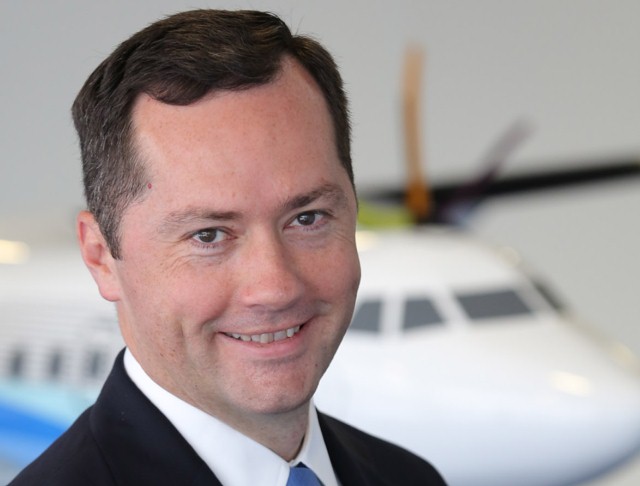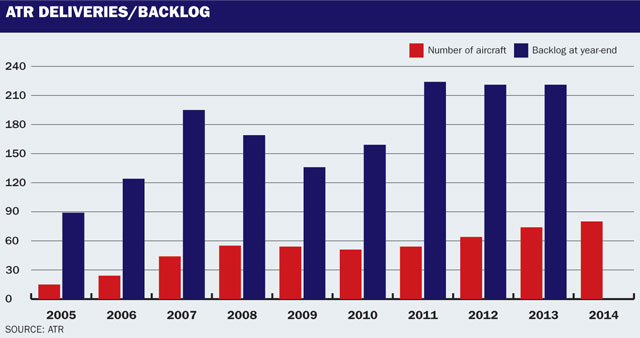The appointment of the Airbus’s head of contract negotiations, Patrick de Castelbajac, as ATR’s new chief executive comes as the Franco-Italian manufacturer works to transform its legal status from “groupement d’intérêt économique” (GIE) to “société anonyme” (SA) to pursue new objectives: managing suppliers, and launching a new turboprop.
De Castelbajac (below), a lawyer, arrives as ATR continues to dominate the turboprop market. Since the beginning of 2014, ATR has booked 107 firm orders; its Canadian rival, Bombardier, has notched only 18.

ATR
ATR took 74% of 2013’s commercial turboprop orders and has secured a 60% market share over the past 10 years. Bombardier, by contrast, accumulated just 17 orders for the Q400 in 2013, way down on the 50 it won in 2012. In terms of deliveries, the Franco-Italian airframer led Bombardier 74 to 29.
Now, it is on course to deliver 84 aircraft this year and is ready to ramp up production to 90 units a year from 2015 onwards, supported by more than 305 aircraft on backlog.
But the manufacturer needs to change its framework to enter a new phase of its development.
ATR is a joint venture of Airbus Group and Alenia Aermacchi, which are also its main suppliers. The wings are built at Airbus Group subsidiary Sogerma in Bordeaux, while the fuselage and tailplane come from Alenia Aermacchi’s plant in Naples. Final assembly is conducted at the turboprop maker’s headquarters in Toulouse.
As Airbus learned in the past, interests do not automatically align when shareholders are also suppliers. While shareholders want minimum cost, suppliers tend to seek maximum revenue.
And supply-chain issues appear to have hampered growth since 2012, with the manufacturer falling short of its delivery targets. In 2012, it delivered 64 units versus 72 planned. Last year, it fell short by six units of its of 80-delivery target.

The first step in ramping up production is the “hardest one”, former ATR chief Filippo Bagnato told Flightglobal earlier this year. Manufacture of aerostructures is the “choke point ATR must resolve”, he said.
The proposed change in legal status may lead to more control over the supply chain and therefore more efficient day-to-day management.
It is also a prerequisite of launching a new 90-seat turboprop, which has been the subject of lobbying to both shareholders for years. Under the current shareholding structure, Airbus Group and Alenia Aermacchi would both have to approve it and financially support the estimated $1.5 billion programme development.
The manufacturer is also in a different financial shape. Last year, it generated $1.63 billion in revenue, up 30% over three years – and a €150 million profit, representing a 9% return on sales. This year, it is on course to achieve $2 billion in revenue. This compares with a $500 million turnover in 2005.
In the past Bagnato said that it would take four years of development to bring a 90-seat aircraft to market.
Research and development is expected to increase over the next few years as ATR may even look beyond a 90-seater turboprop.
Last month, the manufacturer even mentioned demand for a turboprop that could sit up to 120 passengers.
“The market is asking us actually to build a 120-seat turboprop, and this aircraft has to be a totally new design,” said ATR’s general manager sales Asia-Pacific, Christophe Potocki, at the ISTAT Asia conference. But as he pointed out, Airbus in particular has its “priorities elsewhere” at the moment, which is why it has been hesitant to move forward with a larger aircraft design.
Airbus Industrie changed its status to a more simplified joint-stock company in 2001 in the immediate aftermath of the formal A380 launch decision.
ATR may undergo this transformation, too.
Source: Cirium Dashboard























